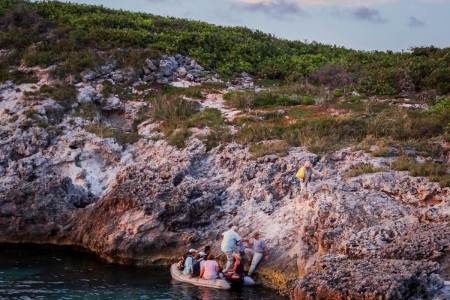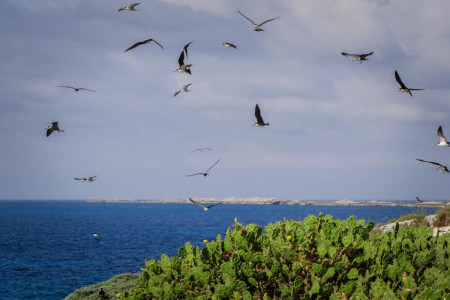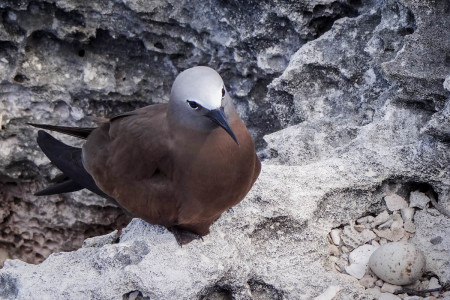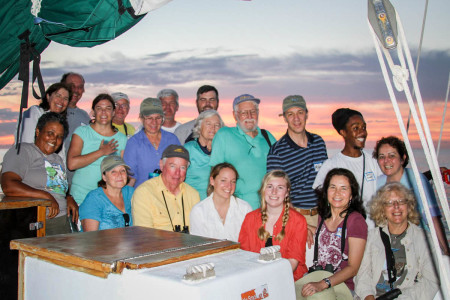
From April 20 to July 15, 2010, the Deepwater Horizon tragedy spewed millions of barrels of oil and coated hundreds of thousands of square miles of the Gulf of Mexico with toxins. Naturalists and scientists who work in the Bahamas began preparing for the possibility that oil would round the tip of Florida and enter Bahamian waters. The Cay Sal Bank, one of the most remote and wild places in the Caribbean Region, was in harm’s way. This 5,000 square kilometer atoll is north of Cuba, Southeast of Florida, and Southwest of Andros, The Bahamas. It is a day-cruise from everywhere, lacks safe harbors, is exposed to rolling seas from all sides. We had very little data about the status of the birds, fisheries, coral reefs, seagrass beds, and small islands. It was known to hold thousands of breeding seabirds, but the most recent scientific visits were in 2000, and no one had ever actually surveyed the colonies. If the oil did coat the Bank, we would not even know what we had lost.

The Bahamas National Trust, The Nature Conservancy, The Royal Bahamian Defence Force, and numerous volunteers quickly organized three trips in May, June, and July of 2010 to document the wildlife on the bank and to determine whether oil was reaching the islands. As a volunteer on the first and third trips, I was astounded by the wilderness that we found. There were hundreds of uninhabited islands with little sign of humans except the occasional grave marker, ruined buildings from abandoned outposts, and plastic and aluminum flotsam from the Anthropocene. These islands are still dominated by birds, sea turtles, and anoles. A quick survey at Elbow Cay showed it was the largest Audubon’s Shearwater colony in the world, and a career’s worth of islands remained to explore and describe for posterity.
Thankfully, unusually strong easterly winds kept the oil in the Gulf of Mexico that year until the well was finally shut off. While tens of thousands of seabirds died from the effects of the spill, likely including individuals that commuted to the spill site from Cay Sal Bank, the oil never reached the Bank in amounts that we detected. We had dodged a bullet, but we don’t want to be caught without data again.

In 2012, we mounted an expedition just to study the birds of Cay Sal Bank. With support and funding from Biodiversity Research Institute (BRI), Defenders of Wildlife, the South Carolina Cooperative Fish and Wildlife Research Unit, BirdsCaribbean, and the National Fish and Wildlife Foundation, we explored the bank again from May 25-31, 2012. Bruce Purdy, expert birder and owner of Blackbeard’s Cruises, captained Sea Explorer, a 65’ sailboat. We recruited an all-star team of nineteen naturalists and seabird experts to spend a full week studying seabirds. Six ecotourists helped fund the trip by purchasing berths on the ship. Our team included well-known Caribbean Ornithologists Ann Haynes-Sutton, Lisa Sorenson, David Wingate, Sonny Bass, and David Lee. In addition, we had the developer of eBird software and knowledgeable birder, Jeff Gerbracht, Boston University Professor and Ornithologist Mike Sorenson and the fantastic mammologist Mary Kay Clark. Deb McKew, a marketing specialist from BRI helped promote and document the trip. Bahamian naturalists Predensa Moore and David Clare of the Bahamas National Trust rounded out our team of volunteer scientists. The ecotourists included Samantha Plencer, Caitlin Howard, Helge Wingate, Kathy Carpenter, David Pais, and Kathryn Sieving, a professor and fantastic ornithologist at the University of Florida in Gainesville who heard about the trip from our advertisement, called up, and signed up on the spot. Lisa Ferguson and myself, Will Mackin, organized the trip and lead the analysis of the data.
What we found was astounding. Every sandy beach on the bank was covered with crawls from nesting sea turtles. Tens of thousands of seabirds nested on Elbow Cay but thousands of others use the small cays we have yet to land on. The four biggest islands on the Bank have introduced rats and fewer seabirds, but we documented about 80 nesting pairs of Roseate Terns at Cotton Cay on the Southeast Corner of the Bank. And the waters of the bank team with life. Perhaps the most spectacular sight was a feeding frenzy including several thousand Brown Noddies and hundreds of Roseate Terns that stretched from the South End of the Elbow Cay to the eastern horizon. They were feeding on larval fish in shallow water with multiple species of jacks pushing bait to the surface.

On the second night of the trip, Lisa Ferguson, David Clare, Samantha Plencer, and I encountered a snake on the surface of Anguilla Cay, an 8-km long, thin island that hosts hundreds of Audubon’s Shearwaters and Bridled Terns. I had never seen a similar snake, so we brought it back to the boat. It turned out to be a Cuban Racer (Cubophis cantherigerus cantherigerus), the first specimen ever caught outside of Cuba. You can read the scientific highlights of the trip in our paper, including a full survey of the birds at Elbow Cay and explorations of wildlife at the other 4 large islands. A paper describing the results of these trips has just been published in the December issue of Waterbirds, the academic journal of the Waterbirds Society. Some people have argued that there is no such thing as wilderness anymore. Those people have never been to the Cay Sal Bank. It is true that no place on earth is untouched by man, but truly wild places do exist where humans are only visitors and wildlife runs the show. When we find one, something inside compels us to work to make sure it stays that way.
By Will Mackin, Conservation Biologist,Seabird Working Group Co-chair, BirdsCaribbean
BirdsCaribbean dedicates this post to our dear friend and colleague, seabird biologist, David Lee, who passed away in 2014.
